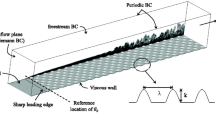Abstract
The flow-field structure in the vicinity and in the wake of an isolated 3D roughness element has been studied. Different experimental techniques have been coupled and supported by CFD simulation for a good understanding of the flow-field topology. The results have shown strong flow-field similarities for different roughness elements. A model describing the flow structure and interaction mechanisms has been proposed. This model is in good agreement with experimental and CFD results as well as the literature.





















Similar content being viewed by others
References
Berry S, Bouslog S, Brauckmann J, Caram J (1998) Shuttle orbiter experimental boundary-layer transition results with isolated roughness. AIAA J Spacecr Rockets 35(3):241–248
Berry S, Horvath T, Hollis B, Thompson R, Harris Hamilton H (2001) X-33 Hypersonic boundary-layer transition. AIAA J Spacecr Rockets 38(5):646–657
Blanchard AE, Lachowicz JT, Wilkinson SP (1997) NASA Langley mach 6 quiet wind-tunnel performances. AIAA J 35(1):23–28
Choudhari M, Li F, Edwards J (2009) Stability analysis of roughness array wake in a high-speed boundary layer, AIAA Paper 2009-0170, 47th AIAA aerospace sciences meeting, Orlando, Florida, Jan 2009
Delery JM (2001) Robert Legendre and Henry Werlé toward the elucidation of three-dimensional separation. Annu Rev Fluid Mech 33:129–154
Eckert E (1956) Engineering relations for heat transfer and friction in high-velocity laminar and turbulent boundary-layer flow over surfaces with constant pressure and temperature. Trans ASME 78:1273–1283
Gregory N, Walker WS (1956) The effect on transition of isolated surface excrescences in the boundary layer, Aeronautical Research Council, R. & M. No. 2779
Grünberg T (2008) The measurement of disturbance levels in the VKI H3 Mach 6 hypersonic wind tunnel, STP report 2008-20, VKI, Belgium
Juliano TJ, Schneider SP, Aradag S, Knight D (2008) Quiet-flow Ludwieg tube for hypersonic transition research. AIAA J 46(7):1757–1763
Morrisette E, Stone D, Whitehead A (1969) Boundary-layer tripping with emphasis on hypersonic flows. In: Proceedings of symposium on viscous drag reduction, Dallas, 1968 (Wells C.S., Plenum Press, Plenum, New York), pp 33–51
Pate SR (1971) Supersonic boundary-layer transition: effect of roughness and freestream disturbances. AIAA J 9(5):797–803
Potter J, Whitfield J (1960) Effects of unit reynolds number, nose bluntness, and roughness on boundary layer transition, Technical Report 256, AGARD Report
Potter J, Whitfield J (1965) Boundary-layer transition under hypersonic conditions. In: Recent developments in boundary layer research: part III, AGARDograph 97, pp 1–61
Reshotko E (2002) Roughness-induced transition growth in a flat-plate boundary layer, AIAA 2002-0138, 40th AIAA aerospace sciences meeting and exhibit, Reno, Nevada
Reshotko E (2007) Is Retheta/Me a meaningful transition criterion ?. In: 45th AIAA aerospace science meeting and exhibit, ed. AIAA, AIAA 2007-943, Reno, Nevada, 8–11 Jan 2007
Reshotko E, Tumin A (2004) Role of transient growth in roughness-induced transition. AIAA J 42(4):766–770
Sackmann L (1936) l’écoulement des fluides au voisinage des points singuliers des obstacles, Publications scientifiques et techniques du Ministère de l’air, No 92
Santarelli P, Charbonnier JM (1999) Heat transfer data reduction user guide for the VKI-H3 wind tunnel, Internal Note 115, von Karman Institute for Fluid Dynamics, Rhode Saint Genèse, Belgium, Feb 1999
Schneider SP (2008) Effect of roughness on hypersonic boundary-layer transition. J Spacecr Rockets 45(2):193–209
Simeonides G (1990) The VKI hypersonic wind tunnels and associated measurement techniques, Technical Memorandum 46, von Karman Institute for Fluid Dynamics, Rhode Saint Genèse, Belgium, Nov 1990
Stainback PC, Kubendran LR (1994) The measurements of disturbance levels in the Langley Research Center 20-inch Mach 6 Tunnel, NASA Contractor Report 4571, pp 1–24
Stainback PC, Wagner RD (1972) A comparison of disturbance levels measured in hypersonic tunnels using hot-wire anemometer and a pitot pressure probe, AIAA paper 72-1003, 7th aerodynamic testing conference, Palo Alto, California, Sept 1972
Strub A (2006) Roughness induced transition in hypersonic boundary layer flows, STP report 2006-08, VKI, Belgium
Thwaites B (1960) Incompressible aerodynamics. Clarendon Press, Oxford, pp 553–554
Tirtey SC (2009) Characterization of a transitional hypersonic boundary layer in wind tunnel and flight conditions, PhD Thesis, VKI, Belgium, Jan 2009
Tirtey SC, Chazot O (2008) Experimental investigation on hypersonic roughness induced transition for EXPERT program, AIAA 2008-2597, 15th AIAA international space planes and hypersonic systems and technologies conference, Dayton, Ohio, 28 April–1 May 2008
Van Driest E, Blumer C (1962) Boundary-layer transition at supersonic speeds—three-dimentional roughness effects (spheres). J Aerospace Sci 29(8):909–916
Van Driest E, Blumer C (1968) Boundary-layer transition at supersonic speeds: roughness effects with heat transfer. AIAA J 6(4):603–607
Walpot L (2002) Development and application of a hypersonic flow solver, Ph.D. Thesis, T.U. Delft University, Nederland
Walpot L, Noeding P, Tarfeld F, Molina R, Gulhan A, Paulat J, Transonic and supersonic static stability analysis of the CARV reentry vehicle, AIAA paper 06-568, 14th AIAA/AHI space planes and hypersonic systems and technologies conference, Canberra, Nov 2006
Walpot L, Noeding P, Schrijer F, Wright M (2010) Base flow investigation of the apollo command module in the frame of AVT- 136, AIAA paper 2010-1468, 48th AIAA aerospace sciences meeting, Orlando, Florida, Jan 2010
Whitfield JD, Iannuzzi FA (1969) Experiments on roughness effects on cone boundary-layer transition up to mach 16. AIAA J 7(3):465–470
Author information
Authors and Affiliations
Corresponding author
Rights and permissions
About this article
Cite this article
Tirtey, S.C., Chazot, O. & Walpot, L. Characterization of hypersonic roughness-induced boundary-layer transition. Exp Fluids 50, 407–418 (2011). https://doi.org/10.1007/s00348-010-0939-4
Received:
Revised:
Accepted:
Published:
Issue Date:
DOI: https://doi.org/10.1007/s00348-010-0939-4




